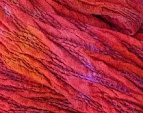It has been my privilege to create another collection of scarves for Pauanesia. This year Heather chose to work with a botanical theme choosing four flowers plus the New Zealand fern.

So from the bottom of the stack we have Pururi, Harakeke, Pohutukawa/Rata, Kotukutuku and Fern on top.
I didn't quite have the order finished before a family trip to Auckland but it was an ideal opportunity to deliver what was ready. On returning home I finished the last half metre of the sixth fern and quickly tied on the Kotukutuku (Tree Fushia) warp and completed the last two.
The Puriri tree can grow up to 20 metres tall and is one of the few NZ native trees with colourful
flowers which can be bright pink to dark red, rose pink or pink blush.
 |
| Pururi |
Common flax or Harakeke grows up to three metres high and its flower stalks can
reach up to four metres. It has seedpods that stand upright from the
stems. Tui, bellbirds/ korimako, saddlebacks/tīeke, short tailed bats/pekapeka,
geckos and several types of insects enjoy nectar from the flax flower.
 |
| Harakeke |
 |
| Pohutukawa flower |
 |
| Pohutukawa |
 |
| Rata flower |
Rata and Pohutukawa are known as New Zealand's native Christmas trees because of the bright red blooms that decorate them during the Christmas and summer season. Rata has glossy, dark green leaves while pohutukawa leaves are leathery and olive green. Trunks on both species are typically gnarled and twisted.
Rata and pohutukawa are closely related (i.e. members of the same genus) and they both belong to the myrtle family, which also includes trees such as guavas, feijoas and eucalypts as well as the native manuka and kanuka.
 |
| Rata/Pohutukawa |
Notice that the Kotukutuku tree has two different coloured flowers. The green flowers let birds know nectar is available while the pink flowers tell the birds not to bother visiting. The trees don't want to waste energy providing a food source if the flower is already pollinated. (Ali McDonald)
 |
| Kotukutuku |
Close up of a couple of the weave patterns. Quite a difference by keeping the same point twill threading but just changing the tieup and treadling.
The silver fern (Cyathea dealbata) has come to embody the spirit of New Zealand.
According to Māori legend, the silver fern once lived in the sea. It was asked to come and live in the forest to play a significant role in guiding the Māori people.
Māori hunters and warriors used the silver underside of the fern leaves to find their way home. When bent over, the fronds would catch the moonlight and illuminate a path through the forest.
This distinctly New Zealand symbol is considered a badge of honour by the people, products and services of our country that carry it. (Tourism NZ)
 |
| Silver fern |
The silver fern (Cyathea dealbata) has come to embody the spirit of New Zealand.
According to Māori legend, the silver fern once lived in the sea. It was asked to come and live in the forest to play a significant role in guiding the Māori people.
Māori hunters and warriors used the silver underside of the fern leaves to find their way home. When bent over, the fronds would catch the moonlight and illuminate a path through the forest.
This distinctly New Zealand symbol is considered a badge of honour by the people, products and services of our country that carry it. (Tourism NZ)
 |
| Fern |









